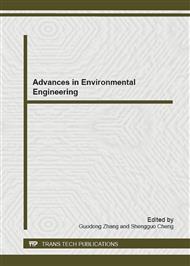[1]
Lei T W et al., 2006. Tracing sediment dynamics and sources in eroding rills with rare earth elements. European Journal of Soil Science 57, 287-294
DOI: 10.1111/j.1365-2389.2005.00737.x
Google Scholar
[2]
Song W et al., 2002. Application of Nuclides on Studies of Soil Erosion. Research of Soil and Water Conservation 9(1), 17-21
Google Scholar
[3]
Liu P L et al., 2001. Experimental study on soil erosion by stable rare earth element tracer method. Chinese Rare Earths 22(2), 37-40
Google Scholar
[4]
Zhang X C et al., 2001. Potential use of rare earth oxides as tracers for soil erosion aggregation studies. Soil Science Society America Journal 65, 1508-1515
DOI: 10.2136/sssaj2001.6551508x
Google Scholar
[5]
A Kimoto et al., 2006. Multi-year tracking of sediment sources in a small agricultural watershed using rare earth elements. Earth Surface Processes and Landforms 31, 1763-1774
DOI: 10.1002/esp.1355
Google Scholar
[6]
V. O. Polyakov, et al., 2009. Tracing sediment movement on a semiarid watershed using Rare Earth Elements. SOIL & WATER MANAGEMENT & CONSERVATION 73(5), 1559-1565
DOI: 10.2136/sssaj2008.0378
Google Scholar
[7]
Liu G et al., 2011. Using beryllium-7 to monitor the relative proportions of interrill and rill erosion from loessal soil slopes in a single rainfall event. Earth Surface Processes and Landforms 36(4), 439-448
DOI: 10.1002/esp.2057
Google Scholar
[8]
Song W et al., 2004. Study on erosion process by the REE tracer method. Advances in Water Science 15(2), 197-201
Google Scholar
[9]
Wu T P, Liu L P, 1997. Research on the Rare Earth Element (REE) Tracer Method of Slope-gully Erosion [J]. RESEARCH OF SOIL AND WATER CONSERVATION 4(2), 69-74
Google Scholar
[10]
Wei X et al., 2009. Simulation experiments on source of eroded sediment from slope-gully systems in loess plateau. Transactions of the Chinese Society of Agricultural Engineering 25(11), 91-96
Google Scholar
[11]
Shi H et al., 1996. A study on sediment sources in a small watershed by using REE tracer method. Science in China (Series E) 26(5), 474-480.
Google Scholar
[12]
Shi H et al., 1997. A study on sediment sources in a small watershed by using REE tracer method. Science in China (Series E) 40(3), 12-20.
DOI: 10.1007/bf02916586
Google Scholar
[13]
Shi H et al., 1997. Study on spatial distribution of erosion yield in a small watershed by simulation experiment. RESEARCH OF SOIL AND WATER CONSERVATION 4(2), 75-84, 95
Google Scholar
[14]
Shi H et al., 1997. Study on temporal distribution of erosion yield in a small watershed by simulation experiment. RESEARCH OF SOIL AND WATER CONSERVATION 4(2), 85-91
Google Scholar
[15]
V. O. Polyakov et al., 2004. Tracking Sediment Redistribution in a Small Watershed: Implications for Agro-landscape Evolution. Earth Surface Processes and Landtbrms 29, 1275-1291
DOI: 10.1002/esp.1094
Google Scholar
[16]
Wang L Q et al., 2011. An experimental study on using rare earth elements to trace phosphorous losses from nonpoint sources. Chemosphere 85, 1075-1079
DOI: 10.1016/j.chemosphere.2011.07.038
Google Scholar
[17]
Hu Q Hi et al., 2003. Effects of pH on distribution of external La between water and benthic soil. Journal of Zhejiang University (Science Edition) 30(3), 306-309
Google Scholar
[18]
M Land et al., 1999. Solid speciation and fractionation of rare earth elements in a spodosolprofile from northern Sweden as revealed by sequential extraction. Chemical Geology 160, 121-138
DOI: 10.1016/s0009-2541(99)00064-9
Google Scholar


